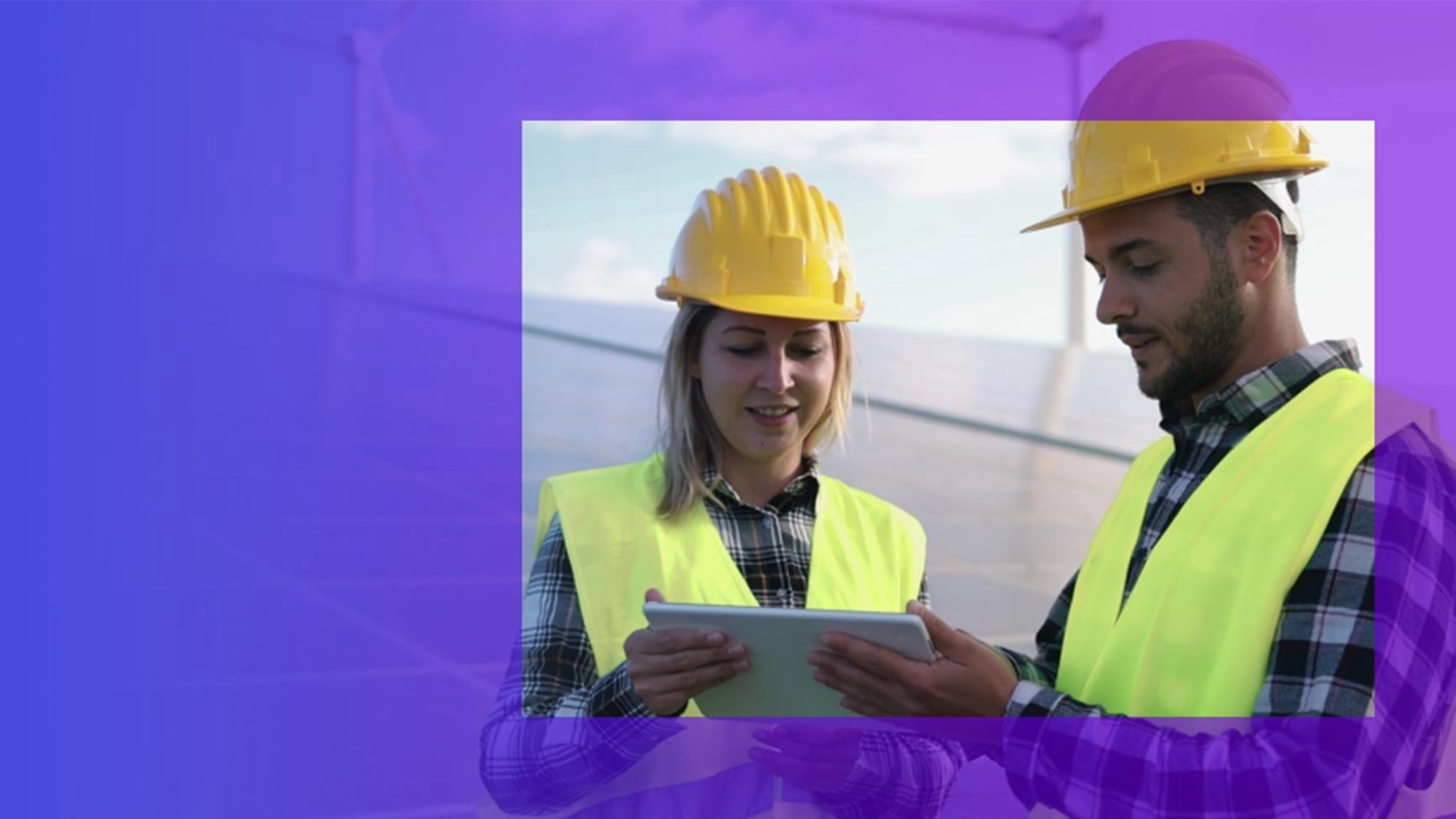Smart grids: A forgotten key to decarbonization
How you can implement smart grids successfully

Authors of this article include: Deven Chhaya, Partner, Infrastructure Advisory, KPMG in Singapore; Nicolas Leonetti, Associate Partner, Operations and Performance Strategy, KPMG in France; Ciarán Rabbitt, Associate Director, Sustainable Infrastructure, KPMG in Ireland: Sophie Shen, Partner, Management Consulting, KPMG China.
The IEA’s Net-Zero by 2050 Roadmap concluded that limiting average global temperatures in line with the Paris Agreement requires tripling global renewable generation capacity by 2030.1 Achieving this ambitious target and successfully integrating such high levels of intermittent renewable energy generation is dependent on delivering electricity grids that provide unprecedented levels of flexibility and intelligence. Transitioning electricity grids to net-zero emissions requires adopting zero-emission power sources and transforming networks to handle electrification across heat, transportation, and industry, as well as shifting from centralized power plants to distributed energy resources. From our perspective, this will be a highly disruptive system, requiring digital technologies to generate and analyze the data critical for network operators to plan and operate ever more sophisticated smart grids, and for consumers to capture the benefits of decentralization. In short, a net-zero grid should first become a smart grid.
Dive into our thinking:
Plugged In third edition - Full report
Download PDFWhat can smart grids accomplish?
Smart grids represent a pivotal shift in how the world manages and distributes electricity. By integrating digital technologies and data analytics, they enable consumers to play an active role in the energy ecosystem and equip network operators with the means to maintain system adequacy with very high levels of renewable penetration. No longer mere energy consumers, individuals can become producers by harnessing renewable energy sources and storage solutions in their homes and businesses. The IEA estimates that realizing the potential of digitalization in grids could reduce the curtailment of variable renewable energy systems by more than 25 percent by 2030, increasing system efficiency and reducing costs for customers.2 This democratization of energy supply diversifies our energy sources, helping to make energy systems more resilient and sustainable.
Moreover, as we increasingly rely on intermittent renewable energy sources, the demand for advanced grid management systems grows. Smart grids tackle this challenge by granting network operators the capacity to handle the variability of renewable energy supply, maintaining the balance between supply and demand. With their real-time monitoring and adaptive control capabilities, smart grids optimize energy distribution, bolstering grid stability and reliability amid the electrification of various economic activities like transport, heating, cooling, and industrial energy demand. Integrating battery storage within smart grids further enhances these benefits by maximizing the value of stored energy and facilitating seamless integration of renewables, thus contributing to a more sustainable and resilient energy infrastructure.
Without the integration of digital and data technologies with physical infrastructure to deliver smart grids, the energy landscape will likely face significant challenges across multiple critical aspects, including:
- Innovation and consumer choice: The absence of smart grids is expected to hinder innovation and risks, limiting consumer choice. Without the ability to efficiently integrate renewable energy sources and optimize grid operations, opportunities for innovation in energy supply and consumption will likely be hindered, depriving consumers of the benefits of a more diverse and sustainable energy system.
- Resilience of energy supply: Traditional grids without smart capabilities often lack the resilience necessary to withstand disruptions and adapt to changing conditions. In the face of natural disasters, cyberattacks, or other unforeseen events, a rigid and inflexible grid would struggle to maintain reliable energy supply, leaving consumers vulnerable to prolonged outages and disruptions.
- Legacy energy supply: Without smart grids that realize the full potential of demand-side flexibility, energy storage and interconnectors, full decarbonization of electricity supplies may not be achieved. This means that consumers may, in part, become stranded with legacy energy sources that impact the environment and become less reliable over time. In our view, the inability to efficiently integrate new energy solutions onto the grid will perpetuate a reliance on fossil fuels, putting the goals of the Paris Agreement at risk. The result of restricting consumers‘ ability to adopt new, cheaper energy sources is expected to be both an increase in the cost of energy and a greater impact on climate change.
- Delivering grid capacity for net zero: The IEA has stated that the world’s grid capacity must double by 2040 if the net-zero challenge will be met.3 Delivering grid capacity at this scale presents significant challenges as new developments are often delayed due to planning and consent approvals, legal challenges and local opposition. Ground-breaking grid technologies that minimize the need for new grid can help unlock additional capacity while avoiding lengthy delays. More widespread use of technologies such as dynamic line rating and power flow controllers are expected to play an increasingly important role in the journey toward net zero by maximizing the use of grid capacity. Effective deployment of flexible grid solutions relies on the seamless integration of such operational technologies into the broader suite of system control and IT tools.
How smart grid technology can help empower utilities and the consumer
Smart grids use technologies, including connected sensors, 5G mobile networks, AI, and digital platforms, to collect and analyze data then communicate with producers, system operators, and consumers to optimize the overall system. Adoption of these technologies enables system operators to implement pioneering decarbonization solutions while allowing consumers to take control of their energy use and interact proactively with energy markets. Some of the benefits can include:
- Cost savings: By optimizing energy distribution and reducing the need for costly infrastructure upgrades, smart grids can deliver significant cost savings for consumers. Cost-reflective tariff design that incentivizes peak demand reduction can minimize the need for a new grid and peaking generation plant, thereby helping to avoid investment. Limiting grid investment can positively impact consumers by helping to minimize the costs that are recovered via electricity bills.
- Enhanced decision-making: Smart grids leverage advanced digital technologies such as AI, automation, and data analytics to provide consumers with real-time insights into their energy usage patterns. This empowers consumers to make informed decisions about their energy consumption habits, identify opportunities for efficiency improvements, and optimize energy usage to help reduce costs. By changing energy use patterns, renewable integration is increased through a better correlation of renewable output and demand.
- Resilience and reliability: With the integration of digital platforms and 5G mobile networks, smart grids enable more efficient energy distribution and management. Advanced monitoring and control capabilities allow for quick detection and response to disruptions, helping to maintain network safety, minimize customer outages and ensure high levels of network reliability.
- Active participation in energy markets: Smart grids that use smart metering infrastructure enable consumers to become active participants in the energy market. Through demand-response programs and time-of-use pricing, consumers can actively shape their energy consumption patterns and even sell excess energy generated from rooftop solar panels back to the grid. Smart grids are expected to accommodate this participation in flexible energy markets by giving operators the capability to manage more diverse power flows across a range of voltage levels and by ensuring adequate interoperability between transmission and distribution grids.
- Increased choice and flexibility: Real-time pricing markets, facilitated by smart grids, offer consumers greater flexibility in managing their energy consumption. Real-time pricing markets can provide valuable data on electricity consumption patterns, which can support more accurate tracking of emissions associated with electricity generation. Smart grids can accelerate the use of real-time pricing markets that incentivize shifting demand to times of higher renewable electricity generation, as well as lower prices, and assist customers in capturing the value of energy storage.4
How technology can help cut the new grid needed to decarbonize
Many electricity grids are planning rapid increases in renewable generation. Previously, given the intermittent output of renewable sources, such a shift would require utilities to use a lot of copper in new cabling and transformers. However, digital technology-driven interventions mean that less physical equipment is needed to manage issues of voltage frequency and harmonics in some cases cutting costs.
China uses real-time data from its new 2,383-kilometer Jiuquan-Hunan transmission line, used to link green electricity generation in the Northwest to consumers in the east, to improve efficiency and minimize loss.
Digitalization can allow faster and more efficient asset development, then replace periodic visits with predictive maintenance that aims to lessen or prevent power cuts while allowing more of this work to take place remotely. Such maintenance can use digital twin technologies that create virtual simulations of equipment, helping to reduce operational risks. In general, smart grids are more resilient and able to heal themselves or require less human intervention to do so.
The road ahead: Successfully implementing smart grids
Smart grids present many benefits for both consumers and utilities, ranging from cost-effective electricity, improved reliability, enhanced grid management and integration of renewable energy. Despite these advantages, some utilities lag in recognizing the significance of smart grids, failing to grasp the implications of renewable intermittency and the transformative shift towards consumer-provider dynamics.
As the energy landscape rapidly evolves, we believe it is imperative for utilities to embrace smart grid technologies wholeheartedly, leveraging them to help improve grid management, reduce operational costs and accelerate the energy transition.
By systematically addressing the following key areas, utilities can pave the way for a successful implementation and adoption of smart grid technologies, helping to unlock their potential.
Transform culture:
- Conduct thorough training programs to educate staff on smart grid technologies and operational implications.
- Provide ongoing support to encourage the adoption of and adaptation to new processes. Recognize and reward employees embracing change.
- Foster a culture of innovation and agility, rewarding experimentation with new technology.
Enhance cybersecurity:
- Implement cybersecurity certifications and regular audits to help ensure compliance with industry standards.
- Deploy secure access technologies like two-factor authentication.
- Conduct routine penetration tests and vulnerability assessments.
- Continuously train staff on cybersecurity leading practices and establish clear incident reporting channels
Consider ethics and data protection:
- Evaluate the ethical implications of increased data access and control.
- Develop robust frameworks for compliance with data protection laws.
- Establish clear guidelines for ethical handling of consumer data.
- Implement transparency and accountability mechanisms in data processes.
Integrate digital platforms:
- Invest in digital platforms for seamless data integration.
- Use advanced analytics for actionable insights.
- Help improve operational efficiency with real-time data utilization.
- Foster collaboration with technology partners for robust digital infrastructure.
Monitor and evaluate:
- Establish performance metrics and key performance indicators for smart grid effectiveness.
- Conduct regular reviews to identify areas for improvement.
- Solicit stakeholder feedback to proactively address of concerns.
- Stay updated on emerging trends for continued innovation.
Commit to collaboration:
- Collaborate with various stakeholders in the energy ecosystem, including energy producers, regulators, consumers and policymakers. Together, develop strategies to rapidly scale renewable generation and energy storage to help create a more resilient energy system.
- Encourage investment through funding and regulations. Regulators play a crucial role in incentivizing energy companies to invest in grid infrastructure to support the transition to a low-carbon energy system. They can achieve this by providing funding, establishing regulatory frameworks and implementing performancebased incentives to help drive investment in sustainable grid infrastructure.
Start your grid development strategy:
- Ensure that the grid investment strategy responds effectively to energy policy and supports delivery of flexible smart grids, including the advanced solutions required for a net-zero world.
- Establish necessary linkages between the grid development and digital strategy.
- Implement agile investment decision-making frameworks and tools that assess costs and benefits for conventional grid solutions along with the new and advanced.
- Develop compelling and robust investment strategies in support of regulatory submissions.
- Ensure that stakeholders and energy consumers are consulted in the process of smart grid development and that their views are reflected in the overall development strategy.
- Ensure that effective program and project management governance and assurance procedures are in place to deliver the smart grid portfolio.
How this connects with what we do
KPMG professionals have deep levels of expertise in energy markets, energy regulation, energy infrastructure development and the challenges faced by different stakeholders within the energy industry and digital landscape.
As a global network, we can draw on experience from other countries and effectively support multinational organizations. We offer an intelligence data platform designed to generate analysis, provide information on assets and carry out forecasting and planning. We can help provide baselining, maturity assessment, support with change management and planning for new networks.
Whether you are facing obstacles in implementing smart grids or looking to explore emerging technologies, our seasoned professionals can help provide insights and approaches that align with your commercial objectives.
Explore more

How artificial intelligence and automation can help transform power and utilities
How you can accelerate innovation responsibly

Plugged In magazine: Third Edition
Harnessing technology to power the future

From threats to anti-fragility: A framework for resilient utilities
How you can embed resilience across an organization

National Grid: Decarbonizing electricity can require ‘lots of grids’ built much faster
An interview with Ben Wilson, Chief Strategy and Regulation Officer at National Grid Group plc
Meet our team
